CRM Strategy? Definition, Examples, and Strategy
A CRM (Customer Relationship Management) strategy is a plan that helps organizations attain specific business goals (typically sales and revenue related) through carefully designed data workflows that are associated with sales and marketing channels using a CRM solution.
The key revenue functions within a business are supported by a CRM strategy when an organization is looking to provide its sales, marketing, and finance departments with valuable data to support its business goals and objectives.
What Is a CRM Strategy?
CRM stands for customer relationship management. It’s a way of using software to manage all your company's relationships and interactions with customers and potential customers.
CRM strategies are crucial for marketing your products and services to your customers. It allows businesses to collect detailed customer information and streamline communication and business processes.
These factors can improve customer expectations, increase conversion rates, boost loyalty and retention, and increase your company’s productivity.
What Is a CRM Tool?
CRM tools help you manage your marketing campaigns. They store contact information for customers and prospects, manage communication workflows, and track service issues.
CRM tools have dashboards that help companies to manage their relationships with customers across various communication channels.
An example of a CRM tool is Semrush CRM, which is built on top of a suite of digital marketing tools that allow agencies to grow their business more effectively.
Here’s how a client page looks using Semrush’s CRM tool:
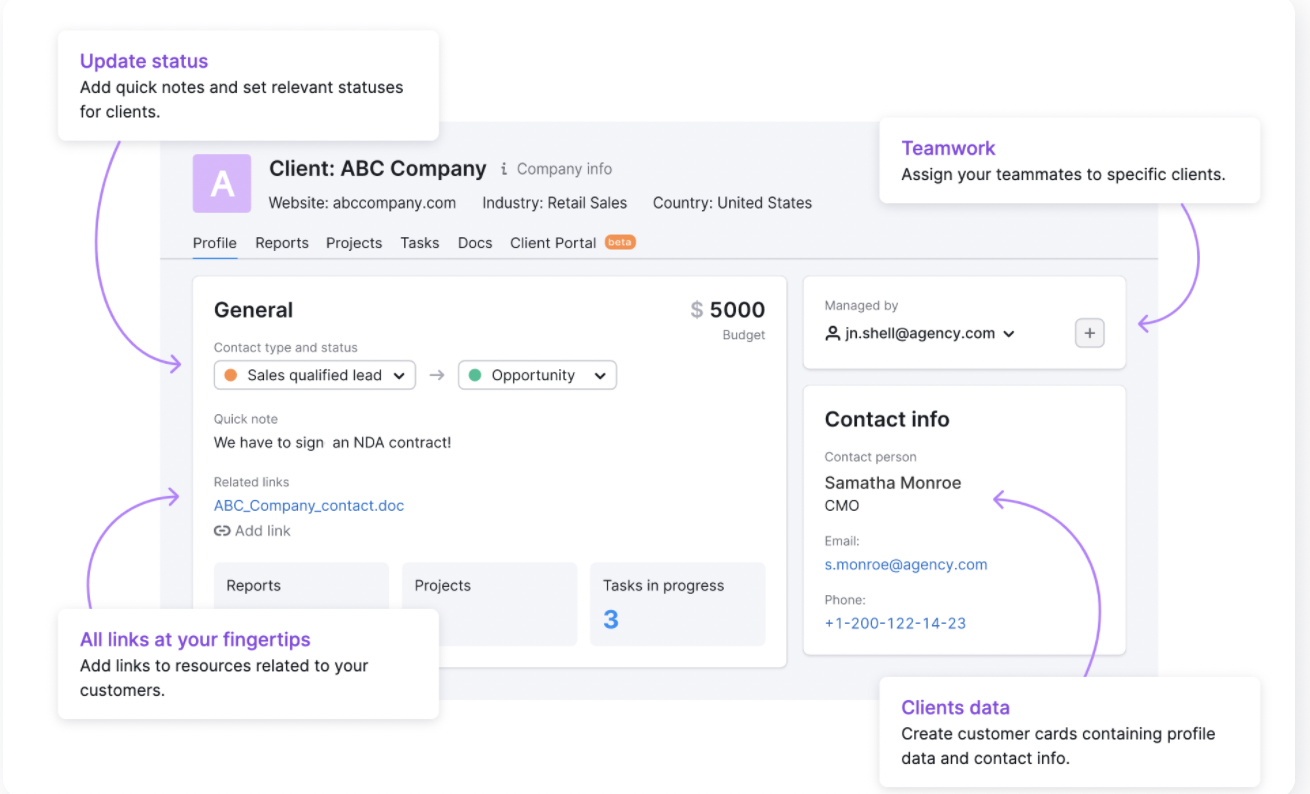
This CRM tool centralizes the data you need for marketing to individual contacts—from their name and title to their phone number and whether they’ve been contacted as part of your marketing campaign.
Semrush CRM can be used to market to both existing and potential customers.
Why You Should Have a CRM Strategy
Understanding everything going on with your business can sometimes feel overwhelming. A CRM strategy will make it easier for you and your team to grapple with all of the activities happening during your marketing campaign.
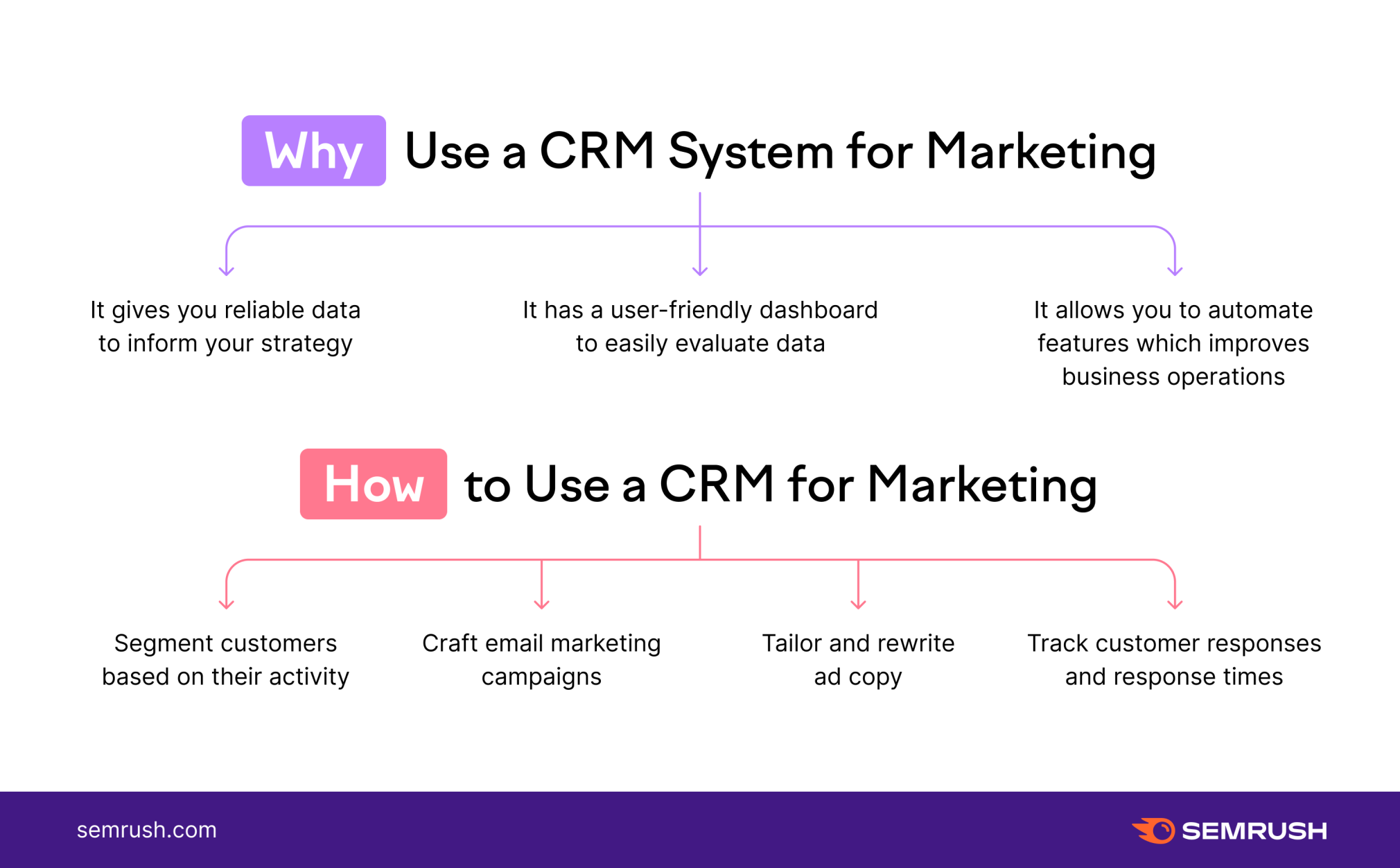
5 Ways You Can Benefit from a CRM Strategy
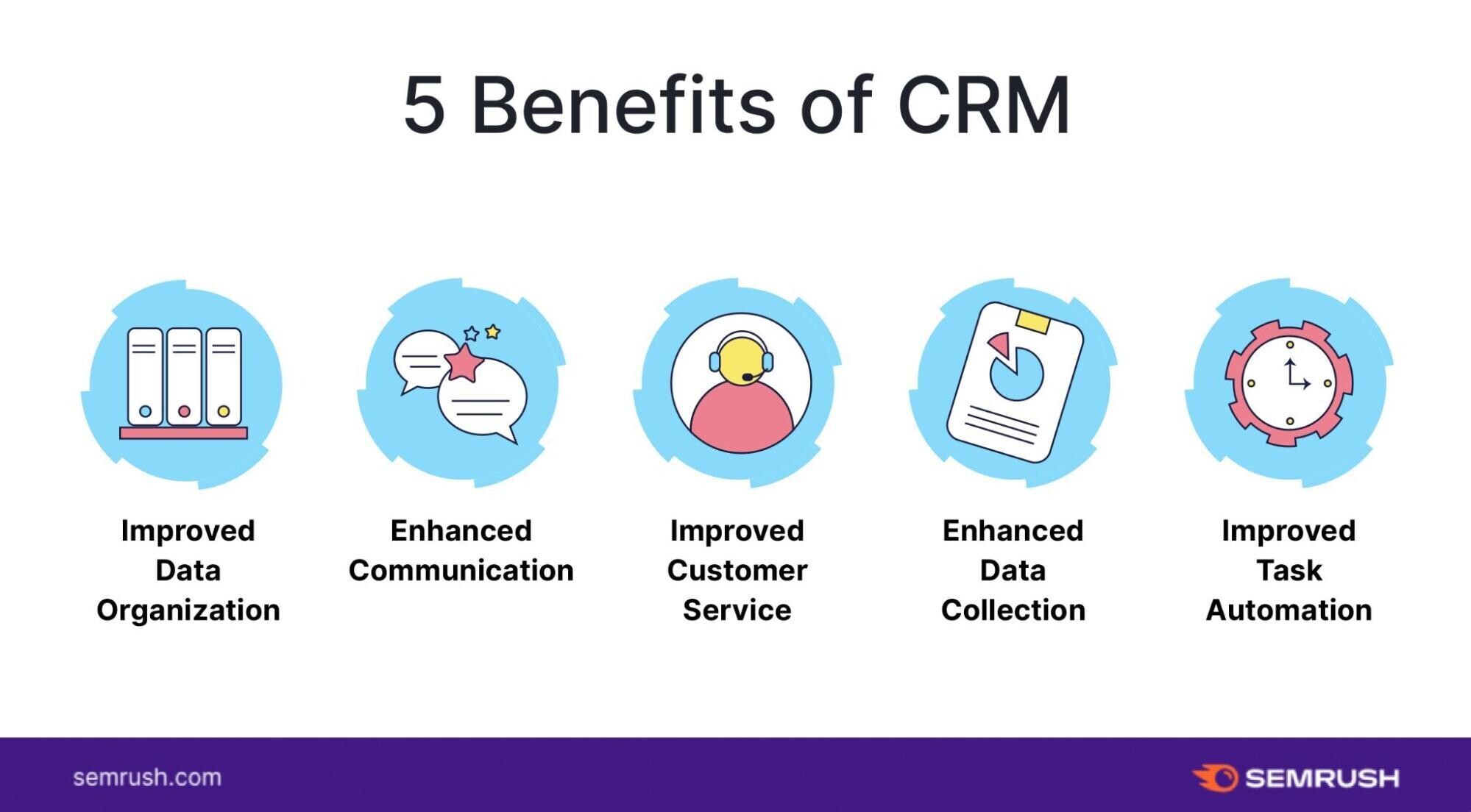
1. Improved Data Organization
A CRM tool provides a central location to house all of the data within your organization. That means you can quickly target the right audience with your marketing campaign.
CRM software makes accessing customer data easy. No matter who handles the customer inquiry, they can view the same actionable information:

With the ability to track everything your customers do and every interaction they have with your business, you can provide them with a better and more personalized experience.
2. Enhanced External Communication
A CRM tool enhances internal and external communication by supplying your team with data to make faster and better decisions.
Your CRM strategy can help you craft messaging for your campaign. And your CRM tool’s automation can increase the effectiveness and timeliness of that communication.
As an example, suppose someone downloads an ebook that you are offering on your website. A CRM tool can be used to automatically send that individual a followup email at a specific time.
3. Improved Customer Service
A CRM strategy can improve the way you interact with customers.
A great CRM tool can give company representatives immediate access to all customer data by storing information about the customer. Like past purchases, preferences, and other behaviors related to their buying decisions.
This information can give you or your customer success team the ability to communicate better with customers and ensure a positive experience.
4. Enhanced Data Collection and Reporting
An effective CRM strategy allows you to easily collect, organize, and analyze data. The CRM-integrated tools and plugins will allow you to generate automatic reports, which will save you loads of time, and improve your efficiency.
And you can follow along on your CRM tool’s dashboard. It will showcase how well your business is performing according to the metrics you define, such as conversions and clicks.
With improved reporting data, you can make meaningful changes to your marketing campaign.
5. Improved Task Automation
CRM strategies improve task automation.
Such as following up with prospects or sending a contract to a client who is ready to buy.
A great CRM strategy will help automate tasks like this on your behalf through automation features. This will save you time and give you the ability to focus on more important tasks.
How to Implement a Successful CRM Strategy
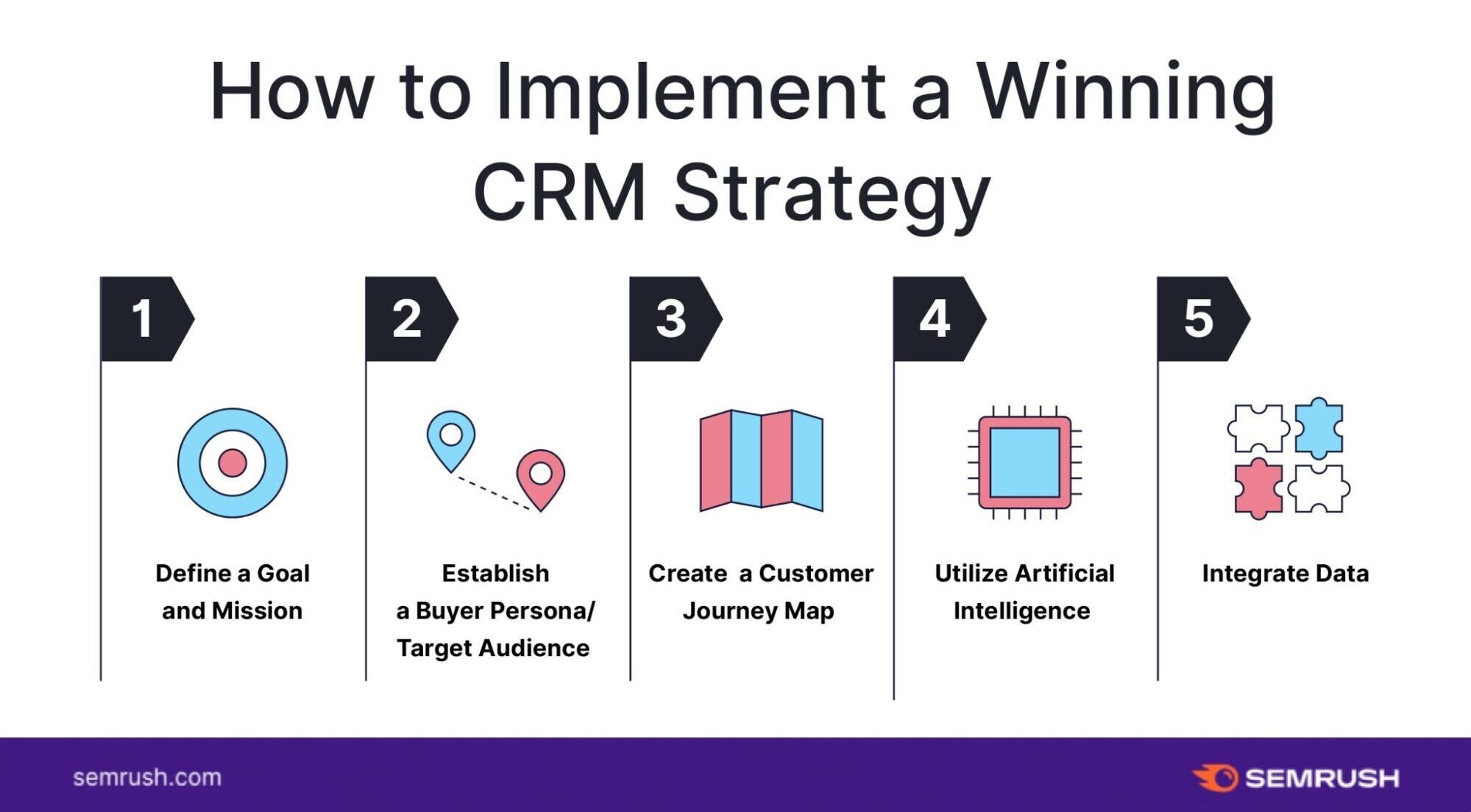
Here are the steps to develop a winning CRM strategy:
Step 1: Define a Goal and Mission
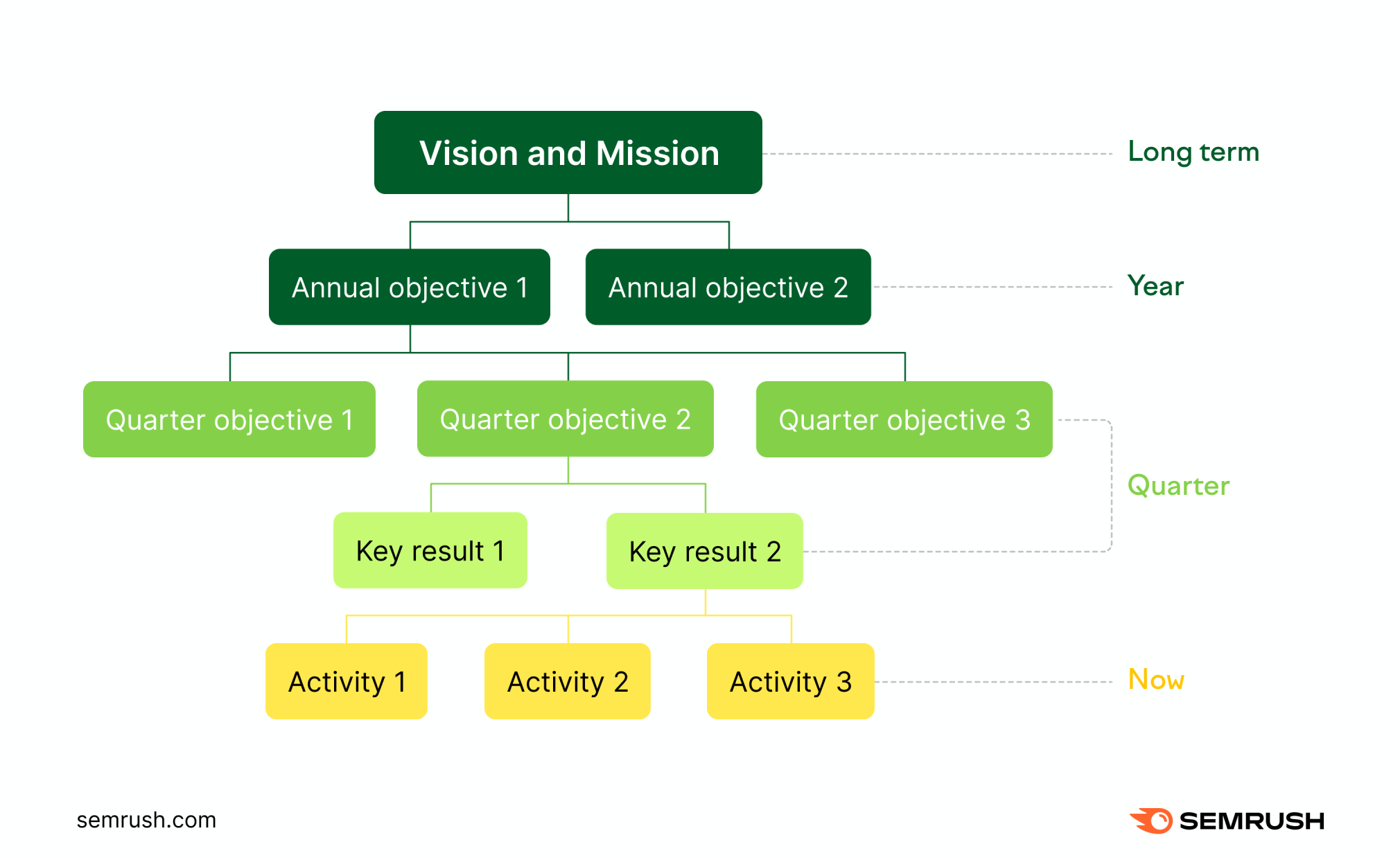
Business goals are endpoints, accomplishments, or targets an organization aims to achieve. They can consist of financial, customer, growth, or employee development goals.
The importance of business goals lies in their ability to provide a clear focus, motivate your employees, and set targets for your business.
The first step to developing a CRM strategy is to ensure that it aligns with the long-term vision and mission of the company. Next, you’ll need to ensure that it aligns with annual objectives and from there determine whether it fits into your short-term objectives.
Ask yourself these questions:
- What do you want to achieve from your CRM strategy?
- How will a CRM strategy improve your sales functions?
- How will a CRM strategy improve your marketing functions?
- How will a CRM strategy improve your customer experience?
- What data will be used to determine if your CRM strategy is a success?
Once you have answers to these questions, you will be able to ensure that everyone on your team is working towards a single purpose.
Step 2: Establish a Buyer Persona and Target Audience
A buyer persona represents your ideal customer, based on insights and market research about a target audience.
Buyer personas are important because they help businesses maintain strong customer relationships and attract new leads.
The purpose of buyer personas when developing a CRM strategy is to ensure that all activities involved in acquiring and serving your customers are captured in your CRM. This requires a solid understanding of who is purchasing from you and the problems they’re facing.
The Semrush buyer persona tool arms you with the ability to create personas for your business:
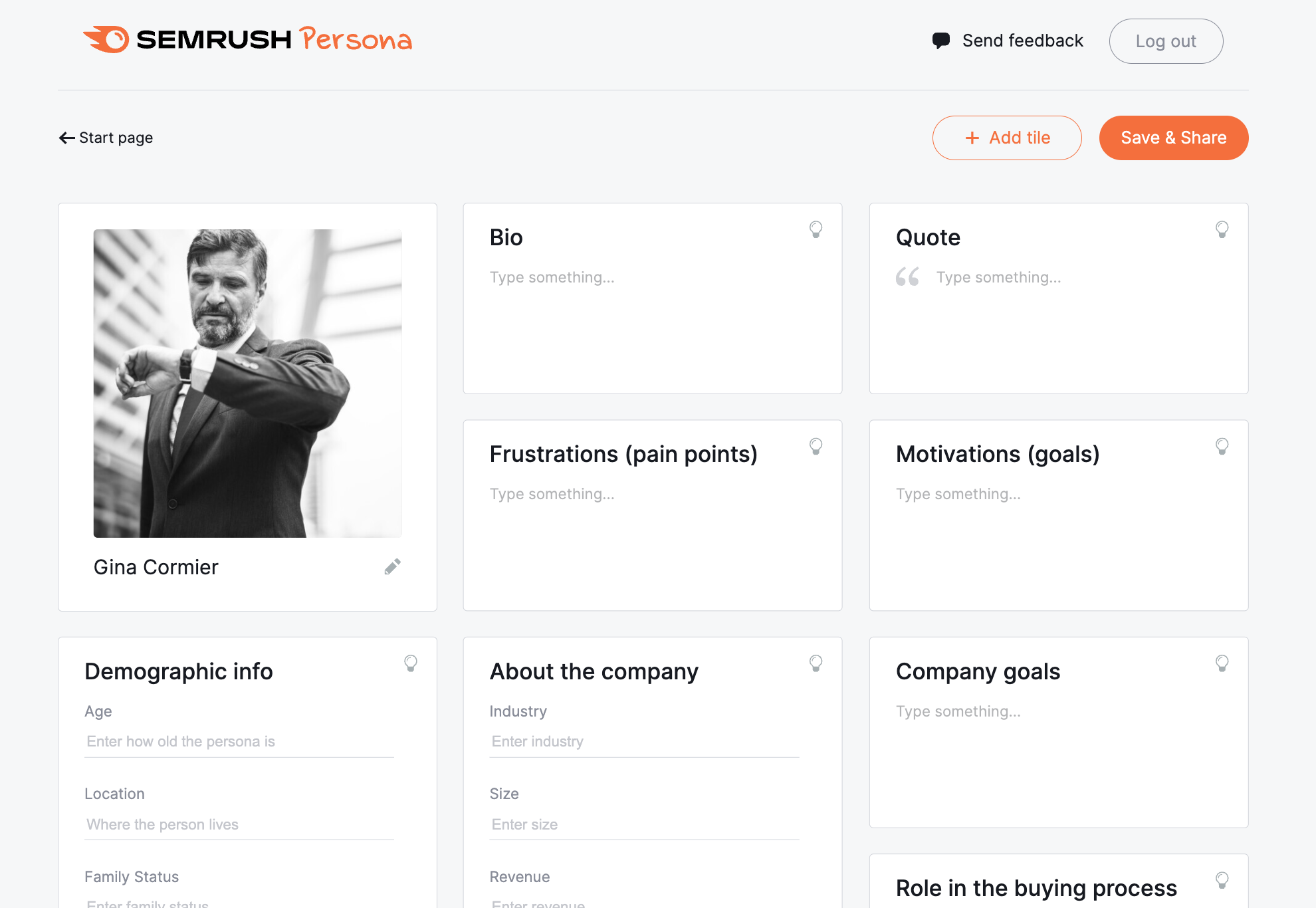
Information that you can include in your buyer persona includes:
- Demographics (like age and gender)
- Values (what influences their decision-making process?)
- Professional information (their job title, skills, industry)
- Goals (what do they want to accomplish and what challenges do they face?)
- And so much more
Once you have this buyer persona identified, the next step is to understand the journey they go through as they become a customer.
Step 3: Create a Customer Journey Map
A customer journey map illustrates how your brand interacts with a customer throughout the buying process. With a customer journey map in place, you can educate your customers about the benefits and solutions your product/service provides, and how it can help them.
There are four stages involved in the customer journey to keep in mind:
- Awareness: This is the stage where customers are first becoming aware of your business and its products and services.
During this stage, you’ll want your marketing efforts to educate your customers about your business and what it offers.
- Consideration: This is the stage where customers are beginning to understand your product and what it offers.
During this stage, it’s important to provide your customers with valuable content to help them understand how your products can solve their problems.
- Decision: During this stage, customers have decided that they want to purchase your product or service. You’ll want to make this process as efficient as possible for them.
This includes having a well-designed, user-friendly website, clear pricing options, and well-trained customer service representatives.
- Loyalty: This is the stage where customers are loyal to your business and advocate for your products and services.
To maintain customer loyalty, it’s important to continually engage with your customers, ask for feedback, and continue creating valuable content.
Now that you understand the stages of the customer journey, you can begin creating your customer journey map.
Consider these questions when mapping your customer journey as a part of your CRM strategy:
- At specific touchpoints, which team or system interacts with the customer?
- What can be done to improve these interactions?
- What data is needed to have quality interactions?
- At each stage, what are the customer's goals?
Step 4: Utilize Artificial Intelligence (AI)
Artificial intelligence is used in CRM to study the success of different sales scenarios. It can provide useful insights and make smart recommendations throughout the sales funnel.
AI can be used in a CRM strategy to:
- Improve customer engagement: AI-powered solutions can help businesses reduce the burden of data entry, freeing up employees to help both existing and potential customers, which improves customer engagement.
- Provide more accurate sales insights:By integrating AI into your CRM, you can improve the accuracy of your data analysis. This can be used for sales forecasting and for gaining insights into how deals are won and lost.
- Enhance networking: Relationship intelligence powered by AI helps companies better understand their client base and the branching networks of prospective clients and referrals. This information is collected and analyzed automatically so teams can quickly understand how to engage with customers and other stakeholders.
Through CRM applications, AI-driven interactions can be captured and leveraged to enhance customer service. Bots can also suggest improvements to customer service processes based on customer feedback.
AI can also be used to determine the quality of customer leads. It can quickly analyze different attributes, such as professional information or their engagement with your website and brand.
Step 5: Improve Communication by Integrating Data
Data integration combines data from various sources into a single view.
This type of collaboration aims to share customer information with other sources and organizations for faster customer service response. A CRM solution can take data from third-party sources and provide you with everything you need to know to have more meaningful interactions with existing and potential customers.
Wrap-up
The goal of a CRM strategy is to improve the customer experience. Make sure you keep that in mind when creating your CRM strategy, and share these best practices with your team so everyone is on the same page.



टिप्पणियाँ
एक टिप्पणी भेजें